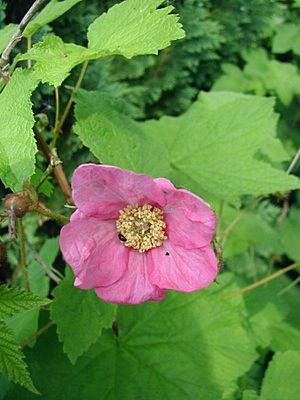Purple-flowered raspberry facts for kids
Quick facts for kids Purple-flowered raspberry |
|
|---|---|
 |
|
| Purple-flowering raspberry cultivated in Denmark | |
| Scientific classification | |
| Genus: |
Rubus
|
| Species: |
odoratus
|
| Synonyms | |
|
Synonymy
Bossekia odorata (L.) Greene
Rubacer columbianum (Millsp.) Rydb. Rubacer odoratum (L.) Rydb. Rubus columbianus (Millsp.) Rydb. Rubus glandulifolius Salisb. Rubus grandifolius Salisb. Rubus quinquelobus Stokes |
|
The Rubus odoratus, also known as the purple-flowered raspberry, flowering raspberry, or Virginia raspberry, is a type of Rubus plant. It grows naturally in eastern North America. You can find it from Nova Scotia in Canada, west to Ontario and Wisconsin, and south along the Appalachian Mountains all the way to Georgia and Alabama.
This plant is a shrub that can grow up to 3 meters (10 feet) tall. Unlike many other raspberry plants, its stems live for many years (they are perennial). Also, a cool fact about this plant is that it does not have thorns, which is different from most other raspberry types.
Its leaves are shaped like a hand with five (sometimes three or seven) parts, similar to maple leaves. They can be as big as 25 centimeters (10 inches) long and wide.
Beautiful Flowers
The flowers of the purple-flowered raspberry are quite large, about 3 to 5 centimeters (1.2 to 2 inches) across. They have five petals that are usually a bright magenta color, but sometimes they can be white. These pretty flowers bloom for a long time, from early spring until early fall.
Edible Fruit
The plant produces red, edible fruit that ripens in late summer to early autumn. The fruit looks like a large, flat raspberry. It is made up of many small parts called drupelets. When you touch or taste it, you might notice it feels a bit fuzzy.
Gallery
Growing and Using This Raspberry
The Rubus odoratus is very popular as an ornamental plant. People love to grow it in their gardens because of its eye-catching flowers that bloom for a long time.
This plant prefers places with some shade, not full sun. It likes soil that is rich and a little bit acidic. It also needs a moderate amount of water to grow well.
Sometimes, this plant can start growing on its own in new places. This is called being naturalized. It has become naturalized in some parts of Washington state in the United States. You can also find it growing wild in parts of Europe, especially in southeastern England.
See also
 In Spanish: Zarza de olor para niños
In Spanish: Zarza de olor para niños






